Sauerkraut Recipe
This page may contain affiliate links. More Information.
A fermented sauerkraut recipe with directions for optional home canning. This sauerkraut recipe involves several separate steps so you might think it will be hard, complicated messy!
Totally wrong impression.
It is actually pretty easy. Just take one step at a time.
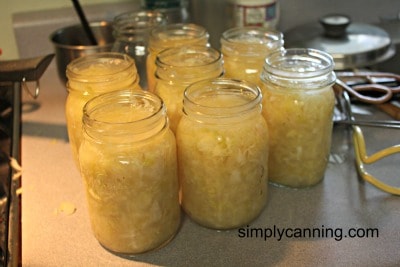
It is a lengthy process, it won’t be over in a day. Most of it is just waiting for the fermentation to happen.
But when you are done….. oh my! The best sauerkraut you can imagine. Doesn’t even compare to the stuff in the cans from the store
Sauerkraut is fermented cabbage. It is the only way it has been tested as safe for storage in jars on a shelf. Remember this is not plain cabbage, don’t skip the fermenting part.
I’ll divide this page into a couple of parts, first a fermented sauerkraut recipe and how to ferment. And then how to store it… which means in the fridge or canning for storage on the shelf.
Canning is totally optional. Heat processing does reduce the health benefits you’ll get from the fermentation process. The probiotics that are produced while fermenting are so very good for you.
But home-canned sauerkraut is still much better than commercially processed. I can’t even eat the store variety anymore. blech.
Fermenting
Preparing your cabbage
Find some nice fresh healthy green cabbage. Remove any outer leaves that are damaged or are wilted. Core the cabbage. The easiest way to do this is to:
- Use a sharp knife and cut the cabbage in half just to one side of the stem.
- Then cut the piece with the stem in half again just to one side of the stem.
- One more cut down the side of the stem should take the core right out.
Next, you will need to slice the cabbage into sliver-thin shreds. I use a mandolin slicer, you can also just use a knife, a food processor, or whatever tools you have.
If you use a knife be sure and get your slices very very thin. You can chop it too if you’d like. Personally, I like more of a shredded texture.

Weigh this cabbage. If you have more than 5 pounds, separate out 5 pounds and place them in a large bowl. Mix in 3 T pickling salt. Mix well, tossing and getting the salt spread out as evenly as possible.
Do this again with your next 5 pounds of cabbage.
You want to mix in 3 Tablespoons of salt for every 5 pounds of cabbage.
Cover cabbage with a cloth and allow it to rest for a few minutes. This will cause it to wilt and soften. It also makes it easier to pack into your jars for fermenting.
Packing your jars or fermenting container
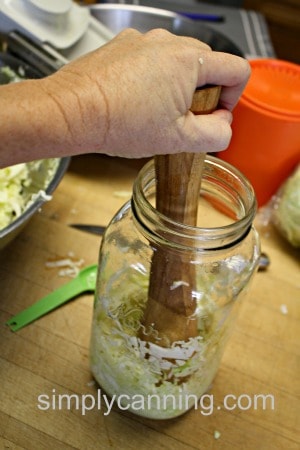
Raw pack your shredded cabbage tightly into jars. I had 3 heads of green cabbage and ended up with 2 half-gallon jars and a one-gallon size jar. Pack it tightly with a wooden spoon or a kraut pounder.
I recently got a kraut pounder. The brand I use calls there’s a Pickle Packer. It is so much easier! I’ve used a spoon in the past. It does work. But the flat end of the pounder pushes the kraut down much better.
It is called a pounder… but if you let the cabbage wilt before you try to pack the jars, you really don’t have to pound. Just a solid pressure down packs it nicely.
As you press the cabbage down juice should be rising to cover it. Stop packing when you are 4 inches or so below the top of your jar. Right around the shoulder of the jar.
If you don’t have enough cabbage juice to fully cover, add some brine to the jars so the cabbage is completely covered with a couple of inches of liquid. Be generous.
Extra Brine Recipe – 1.5 Tablespoons salt to 1 quart water. Just bring this to a boil and let it cool.
Weigh your cabbage down with something to keep it below the brine level.
- Cheesecloth works but not nearly as well as other fermenting lids. I’ve also used a saved leaf from the cabbage itself.
- Pickle Pebbles are another product that I have that work pretty slick.
- If you are using a crock, try using a plate that will just fit inside the crock close to the edges. Place something on top to keep it down. A small jar filled with brine works. The goal is to keep the shredded cabbage submerged.
- The simplest method if you don’t have handy weights, is to place a small brine-filled storage baggie inside the fermenting jar on top. Fill this with a brine mixture, not plain water. If the bag breaks you don’t want to lower the salt content of the brine in the ferment.
Cover your jars. This time around I tested out 3 methods,
- new fermenting lid,
- my airlock (which I’ve used before)
- and simply covered in cheesecloth.
I’ve got a review of the 3 fermenting lid methods and my favorite here.
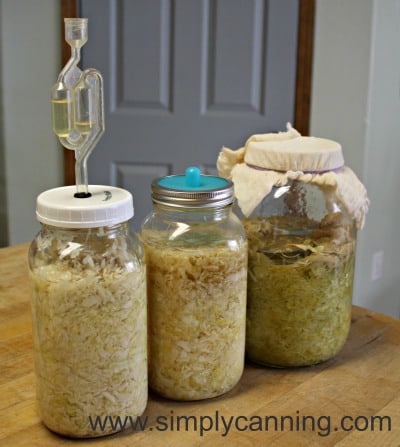
The wait for fermentation.
Now for the fun part. The wait. Store jars in a cool place for 3 to 6 weeks. I label mine with the start date, and an estimated end date so I know when to check it.
As it sits and ferments bubbles will form, that is normal. You may need to press down on the cabbage again to keep it from floating and peeking out above the brine. Keep it covered. This prevents oxygen from getting in.
I like to keep mine in a bowl or pan. Occasionally if you get your container too full, they will bubble over and overflow. Not a big deal but clean-up is easier if you’ve prepared before.
If you have covered your jar with cheesecloth or a cloth, scum may form on top. That is also normal (though icky). This scum should be skimmed off daily. It should not smell ‘bad’. It will smell ferment-y-ish, and well…. like sauerkraut.
This is why I would recommend you consider using one of the choices of fermentation lids that are available. When I use these, I don’t get any scum. To me that makes them worth the purchase. See the link to my review of a couple of different kinds above.
Choose How to Store Sauerkraut
Once your sauerkraut recipe is done you have two choices.
- Move your ferments to a refrigerator and store there. It will last a very long time. Remember this is a fermented product which has all kinds of great health benefits. Probiotics which are great for the gut.
- Process your sauerkraut in a waterbath canner so you can store it on a shelf. (directions below)
I do both. I have jars in my storage and I have a gallon of kraut in the fridge. (well last I checked it was down to the halfway mark.)
It is a simple matter to can it in a boiling water canner so you can store it on the shelf. You can also just place the jars in the fridge.
Canning Sauerkraut
Step one – You will need to heat your sauerkraut before filling your jars for processing. This is a hot pack method. Pour your sauerkraut into a large pot and bring to a low boil.
Step two- Fill jars. Either pint or quart size jars leaving 1/2 inch headspace. Make sure brine covers solid ingredients.
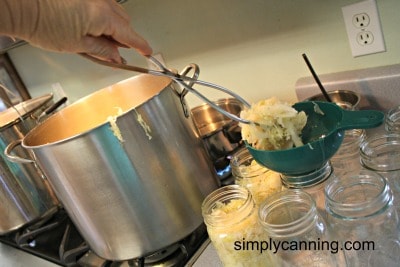
Step 3 – Wipe your rims clean and place your lids on the jars with the screw bands.
Step 4 – Process in a water bath canner according to the process times listed below. Be sure and adjust for both your altitude and jar size.
If you need more on how to use a water bath canner check this page.
Pints are processed for:
- 0-1000 ft / 10 minutes
- 1001-3000 ft / 15 minutes
- 3001-6000 ft / 15 minutes
- 6001 ft- and higher / 20 minutes
Quarts are processed for:
- 0-1000 ft / 15 minutes
- 1001-3000 / 20 minutes
- 3001-6000 / 20 minutes
- 6001 ft and higher / 25 minutes
Remember: This cabbage product is safe for the water bath only because of the fermenting you have done. Please don’t adapt this recipe to unfermented cabbage!
source: NCFHFP
Frequently Asked Questions
A water bath is sufficient for sauerkraut. The fermentation process makes this acidified food. So the pressure is not needed
Yes, the canning process was tested with a hot pack. Some people don’t like to heat their sauerkraut but if you want to can it you’ll need to.
Yes, the canning process does stop fermentation. More importantly, canning does stop the benefits of the probiotics in your fermented sauerkraut.
This is why I like to store some of my sauerkraut without processing and some with. I’ve then got the probiotic benefits of what is in my fridge but my fridge is only so big. The jars on the shelf are great for later convenience.

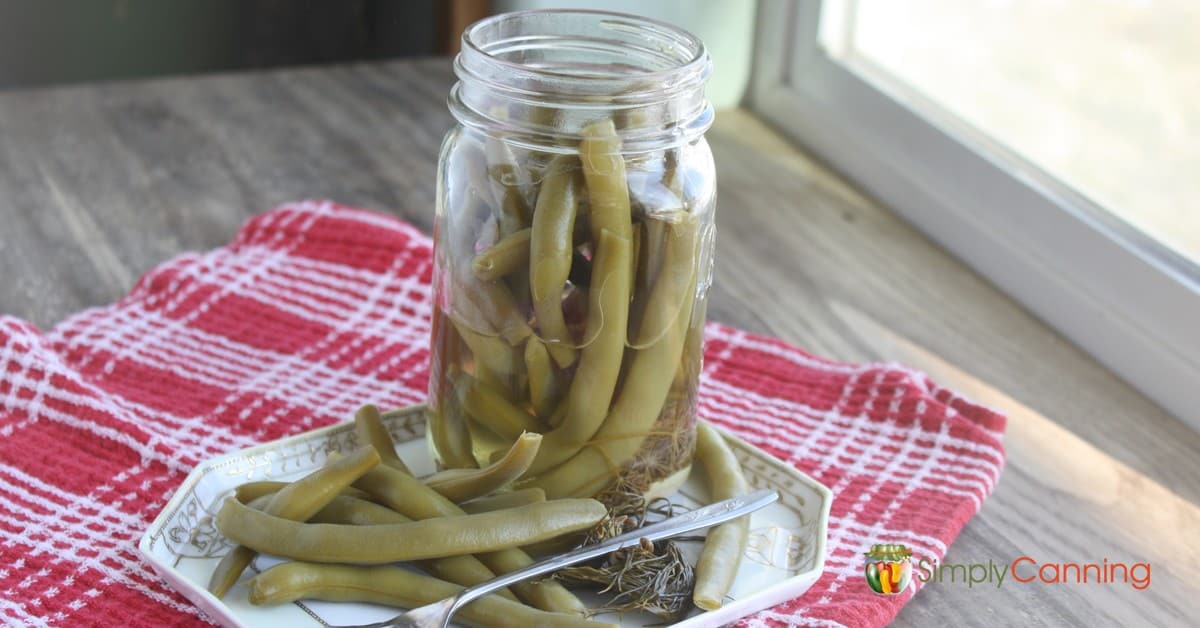

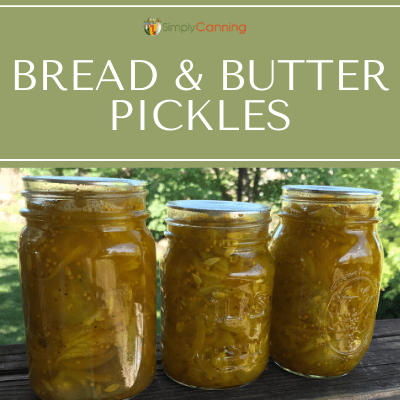
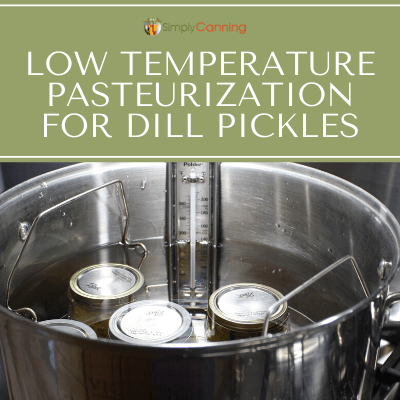
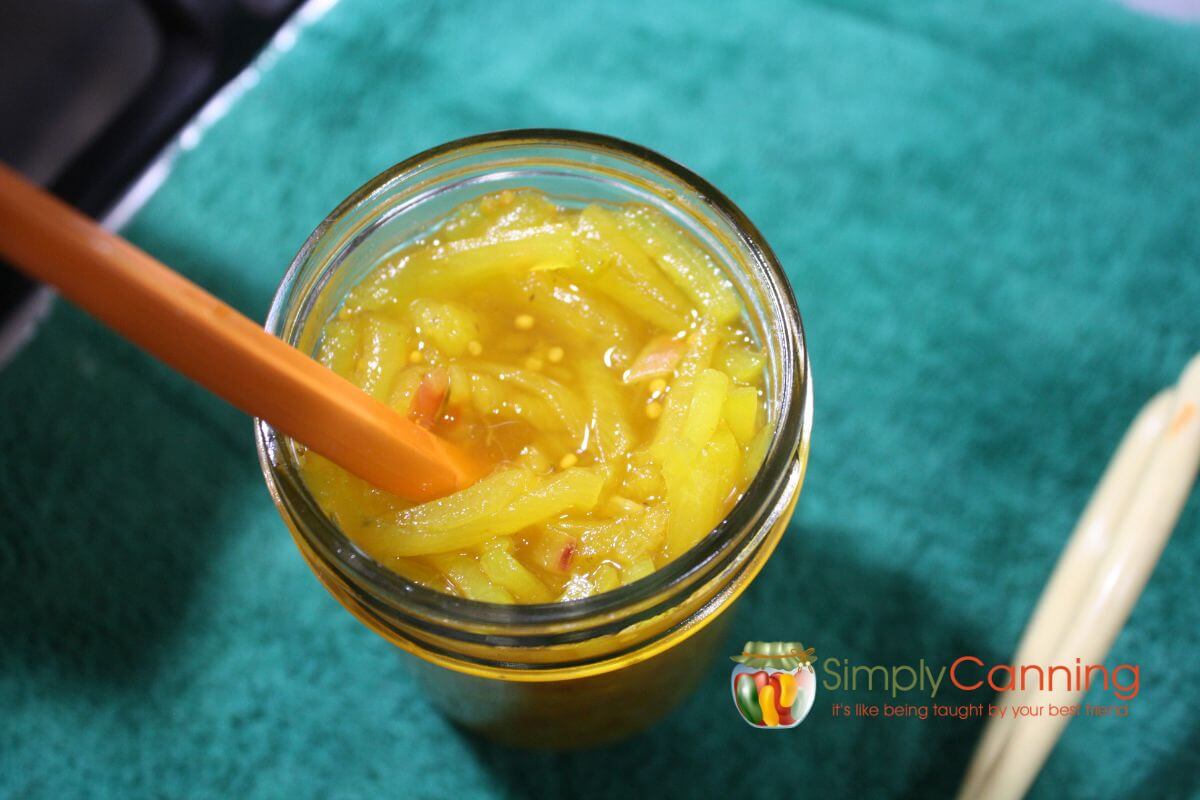
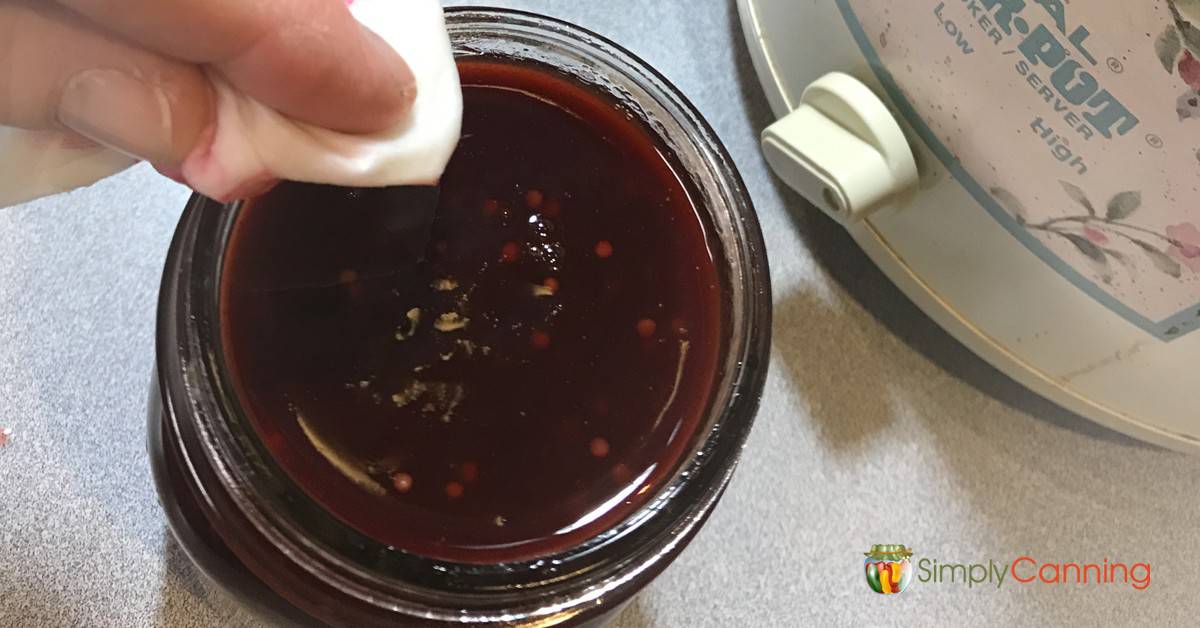
I’m assuming you can remove the pickle pipes and pickle pebbles and just use regular lids when moving to the fridge?
Thanks!
Yes that works fine.
Thanks!
Can I pack the kraut into smaller jars, and, if so, how long do I process them for? My husband is the only one who eats kraut and I’d love to make some myself as I’m sure it will taste better than the cans from the store. But 1 can (about a pint) is too much and he throws it away after about a week because it is mushy. I want to pack my kraut in half- or even quarter-pints for one or two meals for him. Is that possible?
Debbie, Yes you can put your sauerkraut in smaller jars. But you’ll need to process for the pint size. Don’t just cut your time down. Some foods I don’t recommend it for quality issues because the food would be over cooked. But I think sauerkraut would be fine for the longer processing time. You’d have to try it for quality, but it is safe. I’ve got more on using smaller jars when canning here… The other option is to just can it in pint. When he opens a jar, put half of it in the freezer for next time. Again… Read more »
Hi. I have prepped my cabbage and have the fermentation process started. They have been processing for 3.5 days. I am using the pickle pipes as my lids. I made sure that the brine was over the cabbage and I am using whole cabbage leaves to hold the shredded under the brine. Already the brine has increased in the jars and there is no longer a two inch space between the brine and the top of the jar. Do I need to empty out some brine and how often during the process do I need to do so?
Yes, the brine does sometimes swell as it is fermenting. What I do is place my jar in a container or bowl to catch any overflow. On occasion I’ve ended up taking off the pickle pipe and use a non-metallic spoon to press down a bit on the ingredients. This releases some of that air. You could also spoon off some brine if you think more needs to come out. Then just put your pickle pipe back on and continue the process. It should turn out great!
Looking for a recipe for sweet kraut, almost like a relish.
Gregory, I don’t think I’ve seen a recipe like that for canning purposes. If you want to make it to store it in the refrigerator I bet you should be able to find it. I don’t know of one myself. Do a search on fermented sweet sauerkraut. Or something similar. Just remember if you want to store it in jars without refrigeration you’ll need to use a tested recipe like this one. Fermenting and canning are two different methods.
After I let it sit and ferment, can I then can it in the same jar?
No. You’ll want to remove it from the jar and heat it for canning. Follow the steps in the Canning Section for processing.
I’m ready to bottle but there isn’t a lot of liquid left (always had enough to cover while fermenting). Do I worry or just pack my jars?
I would personally take out some of the sauerkraut. Use a slotted spoon and leave as much juice behind as you can. Eat that on brats for dinner tonight. 🙂 Or put it in the fridge. Just take enough so that you’ll have more brine for the sauerkraut that you’ll pack in jars. And then next time remember to be a little more generous with your brine. 🙂
I have been canning kraft for a few years now, ferment for approximately 6 weeks, scrap off top of crock, fill sterilized jars with kraft and hot bath 15 minutes for pints last 2 years we had many jars that turned dark and the taste and texture was wrong, what did we do wrong??.
Hi Shirley, It is hard to say what might have gone wrong. There are many variables with fermenting.
Be sure you are using the proper ratio of salt to cabbage. Check that you are keeping the cabbage down in the brine. There should always be a liquid layer on top. Any cabbage exposed to the air may spoil and mess with the rest of the batch. Make sure you are processing for the correct time for your altitude. (there is a chart above that shows the altitude and time needed.)
Better to use organic cabbage. Might not work with usual produce you buy in supermarkets.
So I put salt on my cabbage and let it wilt for awhile then stuffed it into jars and did a water bath for 25 minutes. All of my jars sealed. Will my cabbage ferment in 3-6 weeks or did I just can cabbage?
Hi Amanda,
Unfortunately, you just canned cabbage, which isn’t considered safe. 🙂 The cabbage has to ferment on the counter before being canned as sauerkraut. It won’t ferment properly in the jars once canned.
-Rachel (Sharon’s assistant)
it has been 8 weeks now
It taste salty is there anyway of removing some of the salt taste before canning
No not really. You don’t want to lower the salt content as that is preservative. Mine is not overly salty so just be sure you are measuring correctly.
After, and only after, canning you could rinse it just before you eat it or add it to your recipe. I also find salts like sea salt or redmond salt leave behind a better flavor as it fermints. I’ve never felt the need to rinse mine. Fair warning though, the minerals in the redmond salt will affect the color of your brine.
I am making kraut for the first time and it has been in a foodgrade bucket for about 3 weeks. When I check it, it does smell like kraut.but there is also a musty/ moldy smell when I first open the bucket. I do believe that where I have it in mybasement, fermentation isgoing to be pretty slow. Is that smell okay? How can I know when/if it’s ready? I’m not seeing scum. But there was a few small spots of mold on top of the plate I am using to weigh it down
Hi Lisa, it is hard to say without knowing just what you did but if it is moldy and smells moldy I don’t think I’d trust it.
How long will it keep in the fridge if not canned?
I’ve kept it for several months.